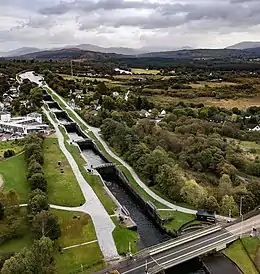
This article gives an overview of the structure of environmental and cultural conservation in Scotland, a constituent country of the United Kingdom.
Upon the introduction of devolved government the environment and built heritage were not listed as reserved issues, and so for the most part conservation is the responsibility of the Scottish Parliament, the Scottish Government, and the public bodies that report to them. Although originally reserved, responsibility for all planning and nature conservation matters at sea up to 200 miles from the Scottish coast was transferred to the Scottish Government in 2008.[1] Some matters related to conservation, such as international treaties and border controls on prohibited species, remain the responsibility of the UK Government.
Much environment legislation in Scotland is based on the adoption into Scots law of European Union directives, such as the Habitats Directive. As such there may be changes to the structure and nature of conservation activities in Scotland following the UK's departure from the European Union.
Scottish Government
Scottish Government directorates
Conservation matters are dealt with across a number of directorates of the Scottish Government:
- Environmental protection, forestry and biodiversity are the responsibility of the Environment and Forestry Directorate.[2]
- The Marine Scotland Directorate is responsible for the integrated management of Scotland's seas.[3]
- The Energy and Climate Change Directorate covers measures to reduce greenhouse gas emissions.[4]
- Cultural Heritage is the responsibility of the Culture, Tourism and Major Events Directorate.[5]
Scottish ministers
Three Cabinet Secretaries hold portfolios with responsibility for conservation issues:
- The Cabinet Secretary for Net Zero, Energy and Transport has ministerial responsibility for many conservation issues, including cross-government co-ordination of Net Zero policy, climate crisis and environmental protection, biodiversity, sustainable development, renewable energy, energy and energy consents, flood prevention and coastal erosion, and water quality.[6]
- The portfolio of the Cabinet Secretary for Rural Affairs and Islands includes ministerial responsibility for agriculture and crofting, fisheries and aquaculture, and forestry.[7]
- The portfolio of the Cabinet Secretary for the Constitution, External Affairs and Culture includes ministerial responsibility for architecture and built heritage.[8]
Public bodies

The following are public bodies of the Scottish Government, with notes on their areas of responsibility.
Executive agencies
- Forestry and Land Scotland is responsible for management of the national forest estate.[9][10]
- Scottish Forestry is responsible for forestry regulation and support.[9][10]
Executive non-departmental public bodies
- Cairngorms National Park Authority
- Historic Environment Scotland is responsible for cultural and built heritage.[11]
- Loch Lomond and the Trossachs National Park Authority
- NatureScot is responsible for landscape protection and wildlife conservation.[12]
- The Royal Botanic Garden Edinburgh undertakes scientific study into plants and their conservation.[13]
- Scottish Environment Protection Agency is responsible for waterways, pollution and waste management.[14]
Public corporations
- Crown Estate Scotland is responsible for managing a range of rural, coastal and marine assets that are held 'in right of the Crown'.[16]
- Scottish Canals manages Scotland's inland waterways.[17]
United Kingdom Government
Within the UK Government, environmental protection is the responsibility of the Department for Environment, Food and Rural Affairs (DEFRA). Two UK-wide executive agencies with responsibility for conservation matters include Scotland within their remit:
- The Joint Nature Conservation Committee (JNCC) co-ordinates the work of the UK's nature conservation bodies (SNH being the Scottish body).[19]
- The Forestry Commission co-ordinates international forestry policy support and certain plant health functions in respect of trees and forestry.[9]
Non-governmental organisations
Many non-governmental organisations are active in conservation issues in Scotland. The following list provides some examples.
- Architectural Heritage Society of Scotland
- Botanical Society of the British Isles
- British Dragonfly Society
- Buglife
- Butterfly Conservation
- Cockburn Association
- Council for British Archaeology
- Historic Churches Scotland
- Institute of Conservation
- John Muir Trust
- Marine Conservation Society
- National Trust for Scotland
- Plantlife
- Royal Scottish Forestry Society
- Royal Society for the Protection of Birds (RSPB Scotland)
- Royal Zoological Society of Scotland
- Scottish Civic Trust
- Scottish Ornithologists' Club
- Scottish Wildcat Association
- Scottish Wildlife Trust
- Society for the Protection of Ancient Buildings
- Trees for Life
- Wildfowl and Wetlands Trust (WWT)
- The Woodland Trust
Protected areas

National environmental designations
National designations for historic and cultural sites
International designations
Local designations
Non-statutory protected areas
Objects of conservation
See also
References
- ↑ Scotland handed sea planning role BBC News, 27 November 2008
- ↑ "Environment and Forestry Directorate". Scottish Government. Retrieved 7 August 2019.
- ↑ "Marine Scotland Directorate". Scottish Government. Retrieved 7 August 2019.
- ↑ "Environment and Forestry Directorate". Scottish Government. Retrieved 7 August 2019.
- ↑ "Culture, Tourism and Major Events Directorate". Scottish Government. Retrieved 7 August 2019.
- ↑ "Cabinet Secretary for Net Zero, Energy and Transport". Scottish Government. Retrieved 20 October 2022.
- ↑ "Cabinet Secretary for Rural Affairs and Islands". Scottish Government. Retrieved 20 October 2022.
- ↑ "Cabinet Secretary for the Constitution, External Affairs and Culture". Scottish Government. Retrieved 20 October 2022.
- 1 2 3 "Forestry devolution: resource list". Scottish Government. 1 April 2019. Retrieved 2 April 2019.
- 1 2 "Report setting out the administrative arrangements that the Scottish Ministers intend to make for the carrying out of their functions under the Forestry and Land Management (Scotland) Act 2018". March 2019. pp. 3–4. Retrieved 8 August 2019.
- ↑ "About Us". Historic Environment Scotland. Retrieved 7 August 2019.
- ↑ "About NatureScot". NatureScot. Retrieved 2 September 2020.
- ↑ "Science and Conservation". Royal Botanic Garden Edinburgh. Retrieved 7 August 2019.
- ↑ "FAQs". Scottish Environment Protection Agency. Retrieved 7 August 2019.
- ↑ "Executive non-departmental public bodies". Scottish Government. Retrieved 8 August 2019.
- ↑ "About Us". Crown Estate Scotland. Archived from the original on 29 September 2022. Retrieved 7 August 2019.
- ↑ "About Us". Scottish Canals. Retrieved 7 August 2019.
- ↑ "Public corporations". Scottish Government. Retrieved 8 August 2019.
- ↑ "The UK". Joint Nature Conservation Committee. Retrieved 7 August 2019.
